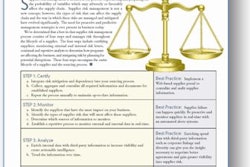
Healthcare spending waste has reached epic proportions in recent years. Several recent studies have shown that healthcare spending waste has reached $500 billion to $850 billion each year! While the largest portion of this staggering sum is spent on inappropriate or unnecessary tests and procedures, there are several additional areas that continue to deplete taxpayer's money.
Waste on this scale opens the door for healthcare reform and no small amount of political maneuvering on the subject. Who can really blame the politicians? Today's situation in healthcare resembles the time in our history when labor unions were formed in the 18th and 19th centuries. They were created in part to counteract ineffective, uncooperative and just plain poor management. Sound familiar?
Healthcare systems need to do a better job in those areas of spending they can control, such as sourcing. Management often succumbs to pressure from physicians and suppliers, but if they take a detailed look at wasteful spending, they can respond to those pressures in a positive, educated way. Two areas ripe with this kind of potential are "physician preference" and "clinical preference" items. Physician and clinical preference items are those high-cost items that often have lower-cost, functional equivalents on the market, but that physicians or clinicians have come to prefer through training, familiarity or habit.
Sourcing for these two categories can be quite difficult because of the seemingly overwhelming number of issues associated with evaluating customized pricing and discounts, outcomes, conversions, service levels and the data required to determine the true cost of the product. When these components are not factored into the equation, money can be left on the table, providing a nice opportunity for politicians to get involved.
Physician preference items, such as cardiology and orthopedic products, typically represent the highest spend for almost every hospital. While it may be difficult to convince a physician to convert to a different product, a best-in-class sourcing process will certainly help to get their buy-in. The time has come to take a serious look into lower-cost products that have the same clinical use and equivalent performance, while not affecting patient treatment or safety.
In clinical preference areas, such as sutures and endomechanical instruments, again, the category is not easy to source. If you evaluate solely using price, some products will be inferior to the preferred item. Conversely, if you take price out of the equation you are certain to pay too much. Hospitals need to send a message to these suppliers that enough is enough, and the vehicle for that message is a solid sourcing event.
The best solution is to prepare a request for proposal that reflects the nuances of these specialty categories and results in the perfect balance of product quality, supplier capability and significant value. Without a carefully tailored and executed RFP process for these kinds of complex categories, you not only lose value, but you also might not select the supplier with the best overall package.
Waste cannot always be attributed to high-tech, high-preference items. Hospital systems can also realize significant value in commodity categories. Reverse auctions provide significant savings by chipping away at the price suppliers are willing to offer. The more hospital systems use reverse auctions, the more savings they will record.
The first step in reducing wasteful spending is to identify sourcing solutions that address the issues unique to healthcare. At BravoSolution, for example, we use our Collaborative Sourcing tools to launch category-specific sourcing events, making it possible to analyze these types of complex, strategic products quickly and thoroughly. These types of tools can also offer built-in category-specific dynamic pricing structures that will help in evaluating tradeoff decisions between price and quality to identify the supplier truly offering the overall best value.
The bottom line is that in the current environment hospitals have to do something. Identifying best-in-class suppliers in physician and clinical preference areas through a quality sourcing event will produce results physicians and clinicians can live with. Conducting reverse auctions on commodity items will significantly reduce prices on those high quantity products. If hospitals take on these challenges and reduce wasteful spending, maybe, just maybe, the politicians can find something else to dig their hands into. Did someone say college football playoff system? ¦












